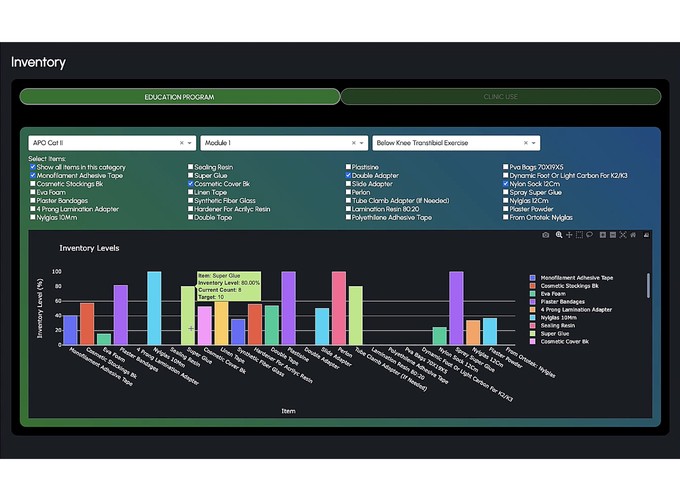In this project, I collaborated with a team of researchers and engineers at the MIT Media Lab, working in partnership with Sierra Leone Orthotic and Prosthetic (O&P) Clinic Technicians to develop an innovative system for tracking inventory and managing the supply chain of assistive device components across the region. Our solution centered on creating a centralized database that aggregates critical supply information from multiple clinics, empowering them to accurately communicate their specific needs to achieve optimal patient treatment outcomes. This groundbreaking approach has the potential to significantly reduce the influx of unnecessary or unusable components while maximizing the efficient delivery of essential supplies, ultimately leading to more effective and timely patient care.
Background

Sierra Leone bears the lasting scars of a brutal civil war that raged from 1991 to 2002. One of the most devastating tactics employed during this conflict was the deliberate dismemberment of civilians, resulting in over 20,000 individuals living with disabilities in the region today. In the aftermath of the war, orthotic and prosthetic care was limited to just three clinics serving the entire country. These facilities primarily relied on sporadic, short-term donations from well-intentioned NGOs. However, this ad hoc approach often led to a mismatch between the supplies provided and the actual needs of the clinics. A poignant example of this disconnect was the donation of a large number of wheelchairs that went unused, as the local infrastructure and road conditions were not suitable for wheelchair mobility.
System Design

To address these challenges, we developed a comprehensive digital solution. At its core is a user-friendly mobile application designed for clinic technicians to efficiently log and manage their supplies. This data is then securely stored in a centralized database hosted on a remote server. To complete the ecosystem, we created a web-based dashboard that pulls information from this central database and presents it in an intuitive, visually appealing format. This dashboard serves as a vital tool for potential donors and stakeholders, providing them with real-time insights into the actual needs of the clinics.
Collaborating with Users on The Ground
Our collaboration with the team in Sierra Leone was crucial in translating our supply chain solution into a practical, user-centric product. We conducted regular Zoom meetings to provide comprehensive tutorials on the application’s functionality. These sessions also served as valuable opportunities to gather feedback and identify areas for improvement. For instance, based on user input, we implemented a feature allowing for the simultaneous updating of supply status for multiple sizes of the same prosthetic component (such as a SACH foot). This iterative, user-driven approach to development resulted in a more refined and effective tool, as evidenced by the positive feedback received from the team.
Mentoring UROPs & Presenting Work
Throughout this project, I had the privilege of mentoring three Undergraduate Research Opportunity Program (UROP) students at MIT. This mentorship focused on nurturing their growth as computer scientists and software engineers. I provided guidance on essential skills such as version control, best practices for code review through pull requests, and techniques for enhancing their presentation abilities. These skills were put into practice during the MIT members week demo days, where our work was showcased to the broader academic community.

Summary
This project represents a significant advancement in the management of assistive device supplies for orthotic and prosthetic clinics in Sierra Leone. By developing a centralized inventory tracking system, we’ve created a solution that bridges the gap between donor intentions and on-the-ground needs. The mobile application and web dashboard work in tandem to provide real-time, accurate information about supply levels and requirements across multiple clinics.
Our collaborative approach, involving close partnerships with local technicians and iterative development based on user feedback, ensured that the final product was not only technologically sound but also practically applicable in the challenging context of post-conflict Sierra Leone. The potential impact of this system is substantial, promising to streamline the supply chain, reduce waste, and ultimately improve the quality and efficiency of care for thousands of individuals living with disabilities. Moreover, this project served as a valuable learning experience for undergraduate researchers, fostering the next generation of socially conscious technologists. By combining cutting-edge technology with a deep understanding of local needs and constraints, we’ve demonstrated the power of interdisciplinary collaboration in addressing complex global health challenges.
